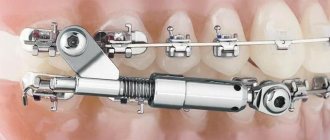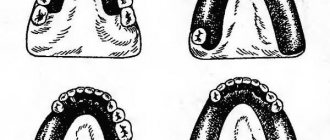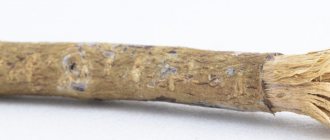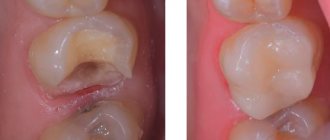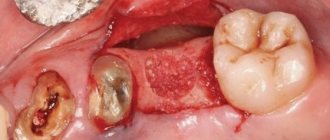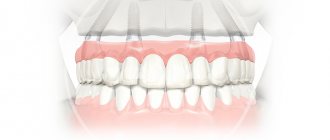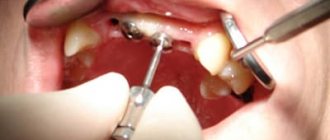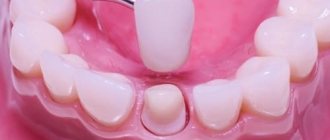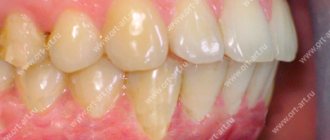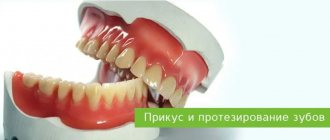A physiologically correct bite is the basis of not only a beautiful smile, but also the quality of the general condition of the entire body. Bite deviations can and should be dealt with regardless of the severity of the defect. Modern orthodontics can cope with any pathologies.
The Herbst appliance is a fixed orthodontic structure designed to correct distal occlusion (when the upper jaw is significantly larger than the lower jaw). Its use can be either an independent method of treatment or an additional means of correction.
Design features of the Herbst apparatus
As you know, distal occlusion is one of the most difficult to treat. This is due to deviations in the development of the entire jaw apparatus, and not just a violation of the position of the dental units.
The Herbst apparatus is made from individual casts of the patient’s jaw from titanium alloys and inert steel.
The design contains:
- two beams (telescopic, articulated, not hindering the natural movements of the jaws);
- four support crowns;
- metal rings for attaching beams to crowns.
Impression from the upper jaw
The procedure consists of 4 stages, according to modern classifications of individual impressions through functional tests. The first test consists of placing spoons on the upper jaw. For this purpose, the patient opens the oral cavity wide. Due to the displacement of the product, it is shortened behind the modular tubercle.
During the second test, the patient sucks in his cheeks. The shedding of the buccal cords is accompanied by a decrease in the size of the spoon around the 6th, 7th and 8th teeth, where the area of the buccal muscles is located.
At the third stage, the upper lip is pulled down and forward. Due to the displacement of the spoon, it is shortened near the 3rd, 4th and 5th teeth.
During the fourth individual test, the patient stretches out his lips with a tube. After displacement, they shorten near the 12 teeth near the incisor muscles.
Functional tests according to Herbst are considered complete if there are no displacements. Fitting is carried out using gentle movements to avoid significant reductions in the boundaries of the base.
Operating principle of the Herbst apparatus
A non-removable orthopedic design is a very active device in its effects.
This effect is possible thanks to its operating principle:
- round-the-clock operation of the device on the patient’s jaw;
- the principle of forced constant pressure on the ligaments and muscles of the dentofacial apparatus, allowing the correct position of the lower jaw to be taken and the growth of the upper jaw to be restrained.
Duration of treatment period
Changes in the patient's appearance occur in the first days after the installation of an orthodontic device.
It takes 4-12 months for the functioning of the joints, ligaments and muscles of the dentofacial apparatus to change. The duration of the treatment period depends solely on the age of the patient and the degree of complexity of the pathology.
Method of taking impressions according to Herbst
The classification of impression making according to Gavrilov calls the Herbst method for the upper and lower jaws a functional test.
The resulting products are evenly connected to the prosthetic fields. For this purpose, an individual dental tray is fitted. At the same time, the frenulums on the cheeks, lower lip and tongue are released with the formation of recesses along the edges of the product. The mucous tubercles become covered completely or in parts. It depends on their size and location.
An important point is the closure of the false maxillary-hyoid lines while maintaining the possibility of saliva excretion through the ducts of the submandibular glands. When creating custom trays for edentulous jaws, it is necessary to take into account possible changes in the structure of the gums.
The main material for clarifying the boundaries of the impression is gypsum. Dentists can also use silicone, which allows them to benefit from its plastic properties for a long period of time.
Preparatory stage for installation of the Herbst apparatus
The complexity of the design requires special preparation of the patient for the installation procedure of the device.
To do this you will need:
- diagnose malocclusion using a comprehensive examination, including taking impressions, radiography, orthopantomogram, etc.;
- complete sanitation of the oral cavity (treatment of caries and inflammatory processes of the mucous membrane, professional hygienic teeth cleaning);
- preparation of upper molars and lower premolars for installation of supporting crowns on them;
- in the case of installing the structure on braces, telescopic beams are attached to their orthodontic arch using special centers;
- the final stage of installation consists of correction and adjustment of the telescopic mechanism.
News
Functional Herbst tests
Herbst tests
individual spoon on the lower jaw.
No matter how the individual tray is prepared, it must be prepared before taking the impression. They do it as follows. First, the frenulum of the lower lip, tongue, as well as the buccal frenulum is released, creating a notch in the edge of the spoon. The guideline for determining the distal border of the spoon is the mucous tubercles. The latter are covered with a spoon partially or completely, depending on their shape, location, consistency, presence or absence of pain on palpation. On the lingual side, in the lateral sections, the spoon should overlap the maxillary-hyoid line, if the latter is round in shape, and reach it if it is sharp. If there is a mental spine and mandibular ridges in the anterior part of the alveolar part, the spoon should block them, leaving the excretory ducts of the sublingual salivary glands free.
Further adjustment of the spoon is carried out using Herbst tests
1) ask the patient to swallow saliva. If at the same time the spoon is thrown off, it is necessary to shorten its edge from the place behind the tubercle to the maxillary-hyoid line;
2) then ask the patient to slowly open his mouth. If the spoon rises from behind, then it is shortened in the area from the tubercles to the place where the second molar will later be located.
3) you can grind the spoon very close to the tubercles, but they should never be left free. If the front part of the spoon is raised, then its edge on the vestibular side is ground off in the area between the fangs; 4) run your tongue along the red border of your lower lip. If the spoon rises, then grind its edge running along the maxillary-hyoid line (4);
5) touch the tip of your tongue to your cheek with your mouth half closed.
6) the place of the necessary correction is located at a distance of 1 cm from the midline on the hyoid edge of the spoon. When the tongue moves to the left, correction may be required on the right; when the tongue moves to the right, correction may be required on the left; 7) run your tongue along the red border of your upper lip. Correction of the edge of the spoon is done at the frenulum of the tongue in a concave manner, but not in the form of a groove.
8) active movements of facial muscles, stretching of lips. If the spoon rises at the same time, then you need to shorten its outer edge between the fangs again. Between the canine and the second premolar along the vestibular edge of the tray there is a place where the edge of it, which goes too deep, is pushed out passively by the tissue. If you place your index fingers slightly below the corners of the mouth and make massaging movements without pressure, then the edge of the spoon that goes too deep can be clearly palpated in the area. All movements, except the last one, must be carried out by the patients themselves. You can verify that the spoon has moved by lightly pressing it with your index finger.
All sharp edges and irregularities that arose during the correction of the edge of the tray must be rounded and polished before inserting it into the oral cavity and applying it to the oral cavity.
The sublingual portion of the edge of the prosthesis forms a particularly important section of the marginal valve. A roller 8-10 mm thick is formed from the thermoplastic mass, thinning towards the ends. After strongly heating the corresponding side, it is glued to the inner edge of the tray between the first premolars. It is very important that the roller fills the sublingual space, but in no case extends the spoon deeper. The roller is softened by passing it several times over the flame of an alcohol lamp or gas burner, cooled slightly and the spoon is inserted into the mouth. The patient presses his tongue on the cheek to the right and left twice (as in test 3) and again puts it on the handle of the spoon, without sticking it out of his mouth. The thickness of the cushion depends on the distance between the sublingual gland and the lower edge of the alveolar part. The greater this distance, the thicker the formed roller. To obtain a functional impression, thermoplastic masses are used. The edges of the impression are formed using the previously described functional tests. Clinical observations by Kh. A. Kalamkarov, V. S. Pogodin and others showed that success in obtaining an impression is ensured by the nature of the samples and the accuracy of their execution, and it is better to use silicone, zinc oxide eugenol, silicone or thermoplastic masses as an impression material.
An individual tray is fitted to the prosthetic bed of the upper jaw according to the following plan. First, the frenulum of the upper lip and cheeks is released, creating recesses for them along the edge of the spoon. Then check the border of the tray behind the alveolar tubercles. The reference point for determining the boundary of the spoon in this area is the place of attachment of the pterygomaxillary fold to the upper jaw. It should not overlap with the spoon. At the same time, line A and the topography of the blind foramina (palatine fossae) are identified. It is necessary that the edge of the spoon on the hard palate overlaps line A by 1-2 mm. After this, they begin to clarify the boundaries of the spoon using Herbst tests: 1) wide opening of the mouth. If at the same time the spoon moves, then the edge must be shortened; 2) sucking of the cheeks. If the spoon is displaced, then its edge in the area of the buccal frenulum should be shortened; 3) stretching of lips. If the spoon is displaced, its edge should be shortened in the anterior section. After fitting the spoons, they begin to obtain a functional impression. A functional impression of the upper edentulous jaw is obtained using silicone masses. Its edges are formed with the same samples that were used when fitting the spoon. The position of the impression along line A is important for stabilizing the prosthesis. At this point, the base of the PSPP should end, extending 1-2 mm onto the soft palate. An impression of the soft palate is taken in an elevated position. If this condition is not met, the impression will be obtained with a lowered palate. In this case, the prosthesis will become poorly fixed during eating and when talking, since the soft palate rises, allowing air to pass under the prosthesis. In order to press out the soft palate when taking an impression, a strip of thermoplastic mass 4-5 mm wide is placed on the palatal edge of the tray. However, it should not be placed on the edge of the tray in a place where it can push back the pterygomaxillary fold. Then the spoon is inserted into the mouth and pressed against the roof of the mouth. When the mass becomes hard, the spoon is removed from the mouth.
Volumetric modeling technique. Herbst tests are convenient for obtaining a functional impression with a preserved alveolar ridge, but are ineffective in difficult clinical conditions that develop with complete atrophy of the alveolar part, especially in the lower jaw. It is rarely possible to create a closing valve here. In addition, conventional methods for obtaining a functional impression do not involve modeling the volume of the prosthesis. Therefore, the prosthesis does not fill the prosthetic space, and the polished surface of the prosthesis does not correspond to the relief of the tongue, cheeks and lips, which leads to displacement of the prosthesis during function. It would be ideal to consider the fulfillment of two conditions: 1) the prosthesis should fill the entire prosthetic space; 2) its polished surface should correspond to the relief of the surrounding tissues. In this case, the resultant of the forces applied to the prosthesis from the lingual and labial sides should be equal to zero. The size of the prosthetic space is individual, as is the process of atrophy. Even in the same subject, it is not the same at different times after tooth loss, since it depends on the degree of atrophy of the alveolar processes of the jaws. With the function of the oral organs, the volume of space also changes
Advantages and disadvantages of the Herbst apparatus
Despite the variety of types of modern orthodontic structures, the Herbst apparatus has a number of advantages that make it possible to successfully eliminate the most complex malocclusion pathologies.
These include:
- simplicity and reliability of design;
- high performance;
- due to the constant impact on the jaw, the therapeutic period of treatment is reduced;
- the adaptation period is practically absent;
- treatment of distal occlusion with the Herbst apparatus for children under 16-17 years of age, in some cases even replaces surgical intervention;
- the possibility of combining treatment with other devices and techniques;
- the enamel of multiple units of the dentition is not damaged;
- the design does not cause discomfort to its owner.
A few disadvantages include:
- quite large size of the device;
- low aesthetics;
- quite labor-intensive hygiene procedures.
Final correction of the bite after removal of the Herbst appliance
After removing the Herbst appliance, the orthodontist usually prescribes wearing orthodontic elastics to achieve more correct and dense interdental contacts.
The myofunctional therapist selects a set of exercises aimed at strengthening the correct functioning of the masticatory muscles and maintaining the lower jaw in a new position.
Commentary by myofunctional therapist T.B. Zukor: “When I prescribe exercises to adult patients, I often hear that there is not enough time to complete them. But the stability of a corrected bite depends on proper muscle function! Nobody wants their teeth to become crooked again, and their jaw to go back, because so much effort has been spent. The exercises are not complicated and do not require special sportswear, location or preparation. Do exercises while driving, standing in a traffic jam, when taking a shower, watching TV - any 5-10 minutes will make a significant contribution to your health!”
Throughout the entire orthodontic treatment, the osteopath relieves excess tension in the muscles and joints and helps to quickly adapt to the new bite.
Retention period after treatment with the Herbst apparatus
The final retention period is no less important than the therapeutic period. Since the non-removable Herbst appliance, as a rule, copes with complex cases of occlusion, retention takes longer than usual (about two years).
After the active influence of the orthodontic structure on the patient’s dental apparatus, his ligaments and muscles, it is important to qualitatively consolidate the functional changes in the new bite.
It is recommended to use retention products about 20 - 22 hours a day, so it is better to choose permanent type retainers.
Impression from the lower jaw
The functional impression takes place in 6 stages:
- The first test is accompanied by installation of the workpiece on the lower jaw. After this, the patient covers his mouth and swallows saliva. During this manipulation, the muscles that compress the pharynx contract. Dropping of the spoon is accompanied by its distal shortening.
- At the second stage, the patient rests his tongue first on the left cheek, and then on the right. When dropping the workpiece, you need to shorten it near the internal oblique lines.
- The third test is performed by touching the corners of the mouth with the patient’s tongue. When the spoon is displaced, it decreases in zones 3, 4 and 5 on the oral side.
- When performing the fourth stage, patients stick out their tongue and try to reach their nose. After this, the tongue is passed along the upper lip. During these manipulations, tension occurs in the chin muscles. If the spoon is displaced, it must be shortened on the front teeth on the side of the mouth.
- The anatomical impression in the fifth test is determined by the tension of the pterygomaxillary muscles when the mouth is wide open. The device is shortened distally.
- The sixth test is used to highlight the vestibular border of the product. The patient retracts his cheeks and when it is displaced, shortening is performed in the area of 6, 7 and 8 teeth. Next, the patient stretches out his lips with a tube. Tension of the chin muscles helps to release the spoon, after which it is done in the appropriate area.
Installation and treatment steps
Before proceeding with the installation of the device, the dentist performs a complete sanitation of the oral cavity. Since the device is attached to the molars, special attention is paid to these teeth. At the same time, the doctor carries out complex treatment, as well as replacing fillings of the entire dentition. Also at the preparatory stage, impressions of the jaws are made, which are sent to the laboratory, where the device is made taking into account the individual characteristics of the patient.
Treatment with the Herbst apparatus is carried out gradually and consists of several stages:
- Preparation. In addition to checking the integrity of teeth, treating diseases, sanitation of the oral cavity and replacing fillings, the doctor may prescribe additional measures and procedures. This may include plastic surgery, removal of interfering teeth, consultation with a speech therapist, training of facial muscles and normalization of breathing. Dentists also strongly recommend getting rid of bad habits, primarily smoking, which reduces the effectiveness of treatment.
- Correction. In some cases, the patient's dental arches are first aligned and the position of the jaws is corrected before fixing them with the apparatus.
- Installation. The Herbst apparatus can be installed separately or in combination with other devices. Most often these are braces.
- Treatment. The patient walks with the installed device, follows the recommended rules and is observed by a doctor.
- Consolidation of the result. After removing the device, the effect is secured by installing retainers. At this stage, the final stabilization of the position of the jaws, tongue and muscles takes place.
